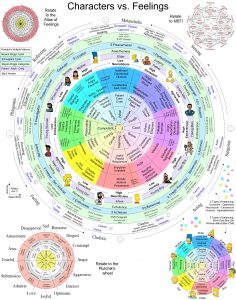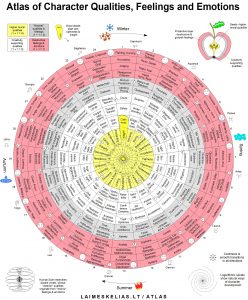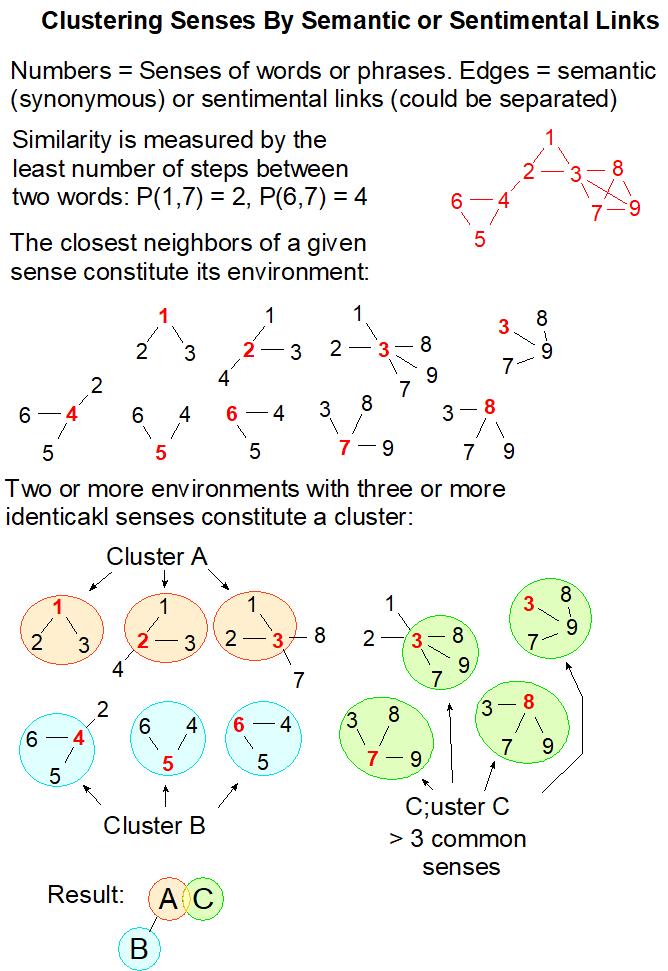“It ain’t what you don’t know that gets you into trouble. It’s what you know for sure that just ain’t so “(Mark Twain). I propose a system that will ‘softly’ balance our judgements and keep us out of trouble. It involves a 3-step plan:
The 1st step involves developing the Dialexity service: submit any text and recieve useful insights and/or reframed views from different perspectives. You can subscribe to a deeper analysis, based on the Enhaced Reasoning and variouws profiling and tuning schemes (see the Useful Insights Portal).
The 2nd step involves finding the allies and ‘how-to” tips for solving any problem: What’s Dialexity? Ultimately it involves developing a comprehensive partnership program, screening all kinds of social networks, and employing custom RSS feeds for finding new ‘how-to’ tips and services

It may also entail developing Dialectical App that transforms your deepest values into success story. All values can be matched with ‘dynamic’ personality traits and motivating information (citations, stories, videos, movies, books, music, graphics, ‘how-to’ advises, friends and experts).

Then, matching people based on their values, moods and characters. It uses atlases of feelings and characters that automatically suggest how a given mood or character can be improved, and which friends can help each other grow (supplementing the existing “tables of relations”, e.g., from socionics for people).

The 3rd step involves developing a smart crowdsourcing platform to accumulate all sorts of facts, arguments and other wisdom and link them in a story of “mutual success”. Smart tokenization should make it automated: the more of your links are used by others, the higher the refund you get!
A good start could be the systemic collections of pros and cons for any important questions – see Dialectic Exposes Bias. It can also include developing the Causal Mapping tool for visualizing the logical flow of any opinions, beliefs, and theories. That would help complement each other’s views rather than struggle.
Most people treat the opposing views based on the “either-or” judgement, as if the world followed just one logical path. In reality there are always many paths, so that most views can complement each other, replacing confrontation with cooperation
Recently I came across a presentation by Tom Scott There is No Algorithm for Truth. I claim that, While formally Tom is right and we create the Truth by ourselves “on the go”, yet a reasonable approximation of the ‘Algorithm for Truth’ CAN still be made!
Earlier Description
Our goal is to connect our feelings, moods and character traits to various practical situations and global internet contents, and transform it to a “problem solving system”

It stems from the Atlas of Feelings (see draft article) that can be integrated with various knowledge bases (Wordnet, Conceptnet, Wiki-How, Good-Reads, Pinterest, etc), and converted into a mood tracking / boosting app. This will allow people to share their experiences and wisdom, eventually covering the entire internet. Graphic visualization of semantic, causality and opinion sequences, as well as Moral Wisdom from Ontology (see Non-Provisional Patent Application), should convert it to a universal problem-solving system
The “Boost Me Up” App will help to track our daily moods, character traits and dilemmas, and provide instant solutions through motivating quotes, videos, stories, and practical advices. See Possible Interfaces. The identified results can be presented in a variety of forms based on “Maturity Profiles” (that will be further systemized and expanded as outlined in the Appendix below)
This app will identify our psychological shortcomings (“internal bottlenecks”), based on localization of red and grey cells, using several self-evaluation scenarios (quick, medium, meticulous). Many our self-delusions can be unmasked by a cascade of dialectical checkups. For example, how to know whether something is an “objective reality”(cell 13-c) or just a “subjective conviction” (13-e)? Checking your feelings in all segments rotated by every 90 degrees will provide an initial estimate: if you are not sure about your Security (1-c), Perseverance (7-c), or Attention (19-c), then you may be in trouble. The reliability of diagnostics is increased by checking all adjacent segments and “non-systemic” relations (“related to”, “confused with”, “incompatible with” relations). The quickest checkup may only take a minute, but the meticulous checkup may require substantial time to go through many iterations

The “Fee-Links” Service. For each problem it will offer daily “neuro-infotainment” – email messages with “Healing Links” that are currently displayed on the right side of the screen (selected quotes, stories, videoclips, practical advices). Some of these links will be offered for free (“Free-Links”), others will require paid subscription (“Fee-Links”). Eventually these links will be empowered by ever-increasing “global concept map” with “sentimental similarity” and “Artificial Wisdom” algorithms
The Crowdsourcing (“Soul-pedia”) Platform. All such “Healing Links” will be crowdsourced by our app’s users (using the “sharing wisdom” option). Each link will be provided with the history of placement and quality ratings from other users. User will be able to rate these links (based on which their authors will be rewarded), share his own links and wisdom pertaining to various cells and situations (psysets), and get rewarded for the accurate placements. Some links may be gathered automatically, using various “concept maps” (like Wiki-How, Good-Reads, Pinterest, Wisdom Quotes, Unionpedia , Babelnet , Conceptnet) or searching internet with specific queries (e.g. “Art of <sense>” – Art of Bravery, or dilemmic TEDx on Brave or Stupid).
“Healing Links” will help to “overcome yourself”, e.g., get rid of harmful habits, stress, loneliness, fear, and so on. Basically it’s NLP, Wellbeing, Mental Health businesses.
The crowdsourcing platform can also be used for rating links between different psysets (“related to”, “confused with”, “incompatible with”), and assigning them with various sentimental indices and dialectical attributes. Both of these will provide a basis for the “global psychological map of humanity” that will make psychology a more fundamental science
Matching People. A user will be able to chat and meet with other people with complimentary mood, character, values, skills. Roughly, if you have any gray / red cells, you need a person with white / yellow cells from 90 and / or 180 angled segments. People with orthogonally oriented pairs of “struggling oppositions” can lift each other to “higher consciousness”, if their white cells are also orthogonally oriented.
Hierarchical indexing. The collected material will be linked with “secondary” and “tertiary” keywords via a hierarchical system. For example, Forrest Gump can be linked to a combination of the strongest “first-impression-words”, like “Handicapped + Boy + Modesty + Perseverance + Success” (primary traits), as well as “Endurance + Obedience + Nobility + …” (secondary traits) , and “Politics + Vietnam + Running + Shrimps + Watergate + …” (tertiary, factual, keywords; a more detailed description is given here). For this we will need “sentimental similarity” algorithms that are outlined below.
The Universal Concept Graph. The starting set of our keywords comes from the wordnet that includes ~ 100,000 common synsets (documented senses after excluding all single-standing technical terms) many of which are available in all major languages (see Open Multilingual Wordnet and UWN with each word in up to 200 languages, also Neo4j freeware for graph visualization)
This graph will be visualized like in Visual Thesaurus or Word Vis (more ideas in the appendix below)
It has to be united with the Conceptnet.io and Babelnet.org– multilingual knowledge bases, representing words and phrases that people use and the common-sense relationships between them
It should be enriched by additional links and sentimental descriptors (from thesauri and emotion annotations) to produce “sentimental similarity” algorithms that convert any messy information into “semantic / sentimental graphs”.
Semantic / Sentimental Similarity. The freely available algorithms are not good enough (as they often consider antonyms to be more similar than synonyms, see appendix below).

Our clustering algorithm showed that wordnet can be clustered into one major graph (~ 30,000 senses) and several dozen smaller graphs that need further interlinking (within each cluster and among all). Thus wordnet has to be enriched by synonyms, near synonyms, antonyms, and near antonyms from other thesauri (like Merriam Webster and Word Hippo, see Appendix for a more extensive list) . Adding the available word-emotion associations could also help
Conceptnet.io – a multilingual knowledge base, representing words and phrases that people use and the common-sense relationships between them
Further improvement can be achieved by assigning each synset (extended to common phrases) with “sentimental descriptors” from categorical emotion annotations and our own crowdsourcing. Few examples of what’s available:
Sentiment and Emotion Lexicons
Valence, Arousal, and Dominance for 20,000 English Words
200,000 commonsense concepts (in 40 languages, indexed by 8 continuous sentiment scales)
Concept Net – semantic network of words’ meanings
Ideally sentimental similarity should be defined by N-D coordinates of any given word or phrase in a space defined by N+1 reference words or phrases. Alan Cowen’s Emotion Maps represent an example of 2-D case of this.
As outlined above, these algorithms will help to map internet contents according to our inner feelings, identify the most direct (yet smooth enough) psychological transformations, get “healing” material when we are in trouble (e.g. deep depression, heartache, etc), and generally find information in a messy environment (typical to most websites of large organizations) through automated conversion of their data into “sentimental graphs” – like Visual Thesaurus, but extending far beyond
The Artificial Wisdom. All synsets and psysets should also be provided with several types of “dialectic attributes” to enable “Artificial Wisdom”:
(i) “Subtlety / marginality” indices measuring the distance of a given sense to the “moral center” of entire concept graph. Currently in the Atlas of Feelings it is represented by letters a-j. This will orient us (and AI algorithms) in the space of moral values. Often we get disoriented due to dismissing broader possibilities. The entire concept graph will show us all such possibilities along with final moral outcomes
(ii) “Under- and over-developed” states, that will enable automated determination of how different senses or concepts interact with each other: strengthen, oppose, create new meanings, remain neutral, or influence interactions of other pairs of senses. For example, under-developed Courage is Cowardice, whereas over-developed Courage is Foolhardiness. Under-developed Creativity is Conformity, whereas over-developed Creativity is Eccentricity. Since both senses (Courage and Creativity) have synonymous under- and over-developed forms, they enhance each other. But if their respective forms were antonymous, they would diminish each other (like Courage and Prudence). A set of senses with mixed interactions may constitute “self-organizing homeostasis” leading to new existential dimensions. E.g., Courage + Creativity + Prudence + Responsibility may lead to Firmness, Brilliance, Foresight, and Resoluteness, whereas Fright + Submission + Safety may lead to maladaptive schemas.
(iii) “Cause – Effect” relations should provide possible reasons for a given sense to occur and outcomes where it could lead. For example, conceptnet/sadness provides “causes of sadness” and “sadness makes you want”. All causes and effects should be of 2 types: short-term and long-term. This will enable the automated generation of the Dialectic Wheels that help solving any problem

The Global Wisdom Network will emerge as a result of crowdsourced concept graph with ever-improving sentimental similarity algorithms and hierarchical linking of all types of internet contents. A three-step procedure will lead the user to the practical results:
(1) identify problem(s) using the Boost Me Up app,
(2) see what these problems are related to, and how others dealt with them, using the Fee-Links service,
(3) get practical suggestions using the AW algorithms and on-fly “situation maps”
Identify. Observe. Solve.
Appendix: Useful Resources & Problems to Be Solved
Enable tagging information on the Atlas – update the existing Heraclitus system

Find / develop system for collecting / correlating various personality / emotions models (see examples of Personality Models’ Correlations)
Finalize app’s possible interfaces, generalize maturity profiles, develop app’s 1st version and try on focus groups
Add Jeffrey Young schemas, optionally Dungeons and Dragons characters, 12 archetype characters, greatest movie characters, archetypes and stock characters for screenwriters, …
Integrate emotion Gifs, optionally Alan Cowen’s emotions’ vocalizations, music, videoclips, cultural flavors, (mapping emotions), Ryerson facial expressions (RML), Ryerson Emotional Speech and Song (RAVDESS), Toronto emotional speech (TESS), Improv spontaneous improvisations (MSP and here)
Potentially, convert moods’ spectra into unique melodies (using SuperCollider or Max/Msp)
Integrate 3rd party tests: Truity Personality Tests, Truity APIs, A Real Me tests, Hexaco, Positive Psychology tests, Gardner’s MI test, Goleman’s EI Test, Global EI Test, Rheti test, IQ Test API, IQ test 1, IQ test 2, Schema Therapy questionaires
Adam Grant and Ray Dalio PrinciplesYou (read and article)
Useful guidance books: Virginia Satir Iceberg Model in Coaching and Psychological Disorders: DSM-5
It is now designed for simultaneous use by only few users. For crowdsourcing purposes it must become like wikipedia.
Instead of using only few thousand wordnet synsets, it must use all available synsets
It is now in English only – other languages must be added too (we have Russian and Lithuanian wordnets, but see Open Multilingual Wordnet and UWN)
We must integrate with Conceptnet.io and/or Babelnet.org. If Conceptnet.io is unavailable, try github download
We must add more synonyms, near synonyms , antonyms and near antonyms from Merriam Webster and Word Hippo and Thesaurus Plus and Thesaurus.com and The Free Dictionary
Visualizing wordnet has not started. See Visual Thesaurus, Word Vis, Via Lab, Github Wordnet Atlas, also Google wordnet visualization and Wordnet alternatives
A hierarchical system for mapping internet could be similar to a goodreads tag system empowered by something like hierarchical tags, extended using Common Sense Knowledge Graphs, hierarchical tag trees, Tag clouds, Tag Spheres, Tagspheres-2, …
Semantic Similarity Algorithm started as synset clustering algorithm that identifies the shortest path between any two wordnet’s synsets. Further development requires enriching wordnet with other thesauri (Merriam Webster and Word Hippo) as outlined above, and possibly adding word-emotion associations
Then expand with datasets of tweets along with annotations to emotions (see also Seemo: a computational approach to see emotions)
What else is available on the internet:
Tools for semantic analysis up to 2017 – from 135 p.
Sentiment Analysis Tools Overview, Part 1. Positive and Negative Words Databases
SocialSent: Domain-Specific Sentiment Lexicons for Computational Social Science
Free software to measure semantic similarity, but the results are disappointing, e.g. prudent + thoughtful (synonyms!) = 0.193, but prudent + careless (antonyms!) = 0.43; eccentric + odd (synonyms!) = 0.35, but eccentric + normal (antonyms!) = 0.275
More of similar algorithms can be found here
Figuring the semantic similarity of words
How to measure semantic similarity of words?
SenseClusters -a package of (mostly) Perl programs that allows a user to cluster similar contexts together recommended by wordnet, another link is here
Google:
affective computing
common sense knowledge graphs
semantic technology
semantic web
Humanity spends uncountable resources for „battling global problems“ while ignoring the very source of all such problems: our relativistic thinking. We propose a system that will identify various „conflicting concepts“ on local and global scales and suggest the ways for their resolution. The Online Atlas of Feelings is an example of such a system for our feelings and character traits (see draft article submitted to the Journal of Philosophy of Emotion). It can also be used for converting all existing knowledge into a „self-sustainable problem solving mechanism“, based on Moral Wisdom from Ontology.
Below we propose a possible development scenario involving several (parallel) directions, each raising an independent commercial potential

